|
04.26.06
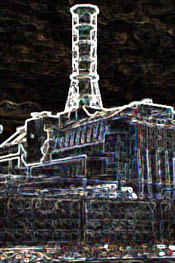 Happy 20th anniversary. Here's Chernobyl as it was last week, when I took a tour organized by the Eurocon, the 28th European Science Fiction Convention, held recently in Kiev. Happy 20th anniversary. Here's Chernobyl as it was last week, when I took a tour organized by the Eurocon, the 28th European Science Fiction Convention, held recently in Kiev.
The bus, with charming, cherry-colored interior curtains that proved invaluable as the sunny day grew warmer, started in Kiev, and for several hours made its way through the countryside, past villages, fields, and forests. It was early spring, and there had been a few warm days. The fruit trees were showing green buds, and the willows splayed out long yellow wands. At one point, we passed a tiny old brick house with a huge stork's nest on the top, just like in the fairytale books. The storks were quite obviously in residence, standing around rather sleepily with their morning coffee, but I was too surprised -- and delighted -- to grab my camera.
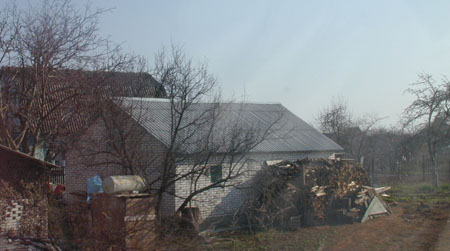
Eventually we came to a monumental cement sign that marked the entrance to the Chernobyl region. Ukraine, with its rich fields and temperate climate, was the breadbasket of the Soviet Union. Brezhnev-era patriotic enthusiasm for a land of wheat-fields and steaming nulear plants is evident in this huge sign, though I suspect the black tint to the steam and the sunflower was added later.


The sign is not the entrance to the restricted zone, however, and after a short open-air rest-stop and photo op, we proceeded some kilometers further to the checkpoint.

The restricted zone does not look much different from the area before it. More lonely, perhaps. The fields were mostly untended, the visible buildings seemed abandoned. There are people who live there without government sanction, who farm the land and eat what they produce, but they number only a few hundred for the entire region. We didn't see many people or cars on the main road.

We crossed the Pripyat River, which drains into the Dniepro, from which Kiev takes its water.

Prezwalski's horses, wild ponies native to the area, have been reintroduced, and are making a strong comeback. To a busload of tourists, however, they are just shadows moving through the grassland. We had been told in advance to try to stay on the pavement, and to avoid walking on dirt and moss. Any heavy metals in the dust or rain wash off the pavement when it rains and sink into the soil.


The firefighters who responded to the initial alarm are justly honored in several monuments in the region. They all died of heat trauma or radiation poisoning after the accident. This recent sculpture indicates that Ukraine's gratitude is still deeply felt.

Below, a Soviet-era monument to the firefighters, still tidy and well landscaped, though I'd bet those fir trees have been replaced a few times.

Chernobyl reactors used water from the Pripyat River for cooling, and rain runoff from the Chernobyl plants drains into the Pripyat, just as the leaking reactors at the Hanford Reservation in Washington State drain into the Columbia River.

A view, through the bus window, to Reactor 4, the site of the accident.

This is pretty much as close as you're allowed to get to Reactor 4, from just outside the visitor center. It's certainly as close as you're allowed to photograph. And, judging from the radiation levels at the visitor-center windows that face the reactor, it's as close as you'd want to get, too.

The visitor center has a cheerfully painted scale model of the damaged reactor that swings open for inspection. A well-informed spokeswoman gave a direct and detailed lecture and answered questions frankly.

Conditions inside the reactor are still too dangerous for workers to stay inside more than 30 minutes each, and rubble in the interior is too hot to remove, even if there were somewhere to put it. The pink golf flags are in the scale model only. Inside the actual reactor, it is dark and dangerously damp.

The current efforts at keeping moisture out and radioactive dust in are failing. Water gets into the reactor when it rains, and radioactive vapor and dust escape. A new containment building is still in the final stages of planning, and will not be completed until at least 2010. The melted reactor core is not only immensely hot, it is not under control, even after 20 years. It could go critical again with little warning.

As elsewhere in Eastern Europe, workers in Ukraine often wield brooms made of small branches. To a Western eye, it casts a fairy-tale aspect, especially surreal in the shadow of a nuclear plant.

The ghost city of Pripyat, which will be uninhabitable until it has crumbled to dust, was built for workers at the nuclear plants. It was to be a model Soviet city, a reward for the workers who delivered nuclear power and an example of Brezhnev-era modernity.

Website branding does not stop at the gates to Pripyat. Pripyat.com is a site dedicated to remembering the city and its inhabitants, and to fostering awareness about what is happening now in the Chernobyl region.

The town center of Pripyat. The tall building is the Hotel Rossiya.

This was the heart of town, theater, cinema, restaurants, May Day celebrations....

Graffiti artists from Belarus, Russia, and Germany have left their mark, at some risk to themselves. Their ghost people are evocative and enigmatic. Their website is a bit overblown, but well worth checking out if you have broadband: 26-04-1986.com.
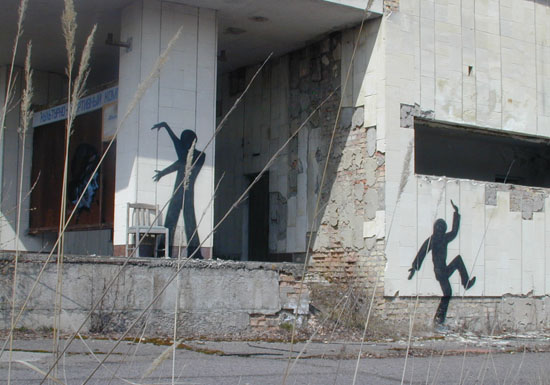
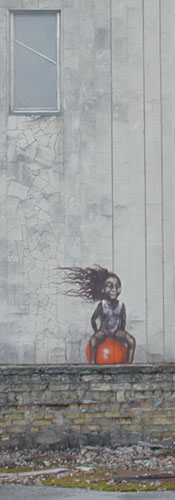
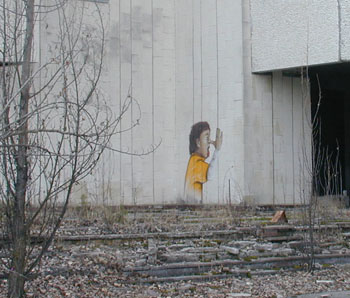
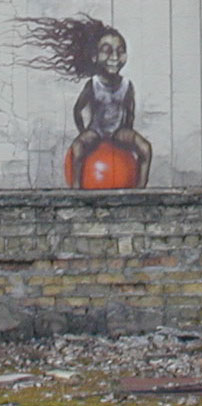
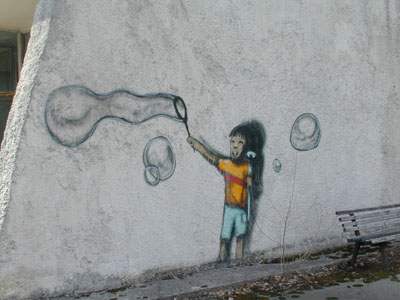
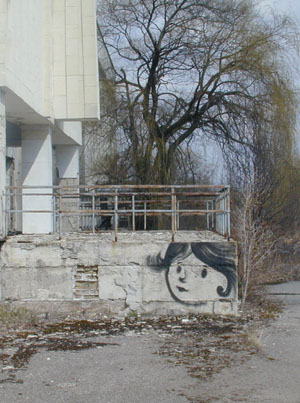
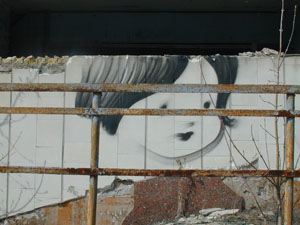
Abandonded amsuement parks are creepy even when they're not radioactive. This park never operated: it was due to open a few days after the accident.

Looks as thougth somebody started to swipe the steering column, then had second thoughts. A lot of scrap metal has vanished from Pripyat.

Big glowing eyes look out from here and there. Part of the original design? Or graffiti?

The climate is humid, and has taken its toll on the schools as well as the amusement park. This building was too damaged for us to go into. It looks as though it has been looted in years past.

A couplet promoting racial harmony within the Soviet Union.

There are still a few photos on the honor roll bulletin board.

Graduating class? The paper suits make everyone look like a teddie bear. The lettering says pripyat.com. We felt a little silly putting them on, but at the end of the day, I was happy to discard the suit and any dust it may have gathered. I also washed my shoes and sent my clothes off to be laundered. Paranoid? Moi?

A village near the administration building, a few kilometers from the nuclear plants, looks over-run, but may have some elderly residents. I noticed a tiny old lady in a scarlet headscarf walking down the street. She did not look like an adminstrative employee.

Once-tidy fences and gardens are overgrown with brush. There were a few houses that looked in reasonable repair. (I didn't include them here, out of respect for the occupants.) About 4000 people still work at Chernobyl, two weeks on and two weeks off. There's still a lot to do here.

Mysterious, peripatetic metal objects are found nearby. How do they get around? Abandoned by scavengers?

Another cheerful Brezhnev-era vision, on the way out of the area, anticipating the power and prosperity that nuclear energy will bring.

A final stop at a small abandoned village, apparently well south of the most contaminated area. (Although contamination seems to be patchy and unpredictable.)

There was a smell of woodsmoke in the air, and it was obvious that, nearby, people had resettled the area, however wise that may have been. But this village, with houses that were obviously a century old or more, was empty and rotting in place. Later, not too far away, we passed a cemetary that was obviously well kept up. People come back here to tidy their family graves, and even to be buried.

Cozy houses, apple trees ready to bloom, firewood carefully stacked, solid outbuildings. The owners, whose families may have been there for many generations, were evacuated with little notice and only what they could carry, and resettled in highrise apartments in Kiev and elsewhere. The houses are full of photos, letters, and other emotionally important posessions. Seeing this toll taken against a way of life, over a large area of Ukraine and Belarus, touched my heart. It was the large event writ small.

Back in Kiev, a stenciled graffiti has the last word.

It's twenty years today since the world's most serious nuclear disaster began, and it hasn't ended yet. Ukraine and the states around it, especially Belarus, are still actively threatened by Plant #4 at the Chernobyl nuclear power station. Radiation itself is invisible, and its effects are insidious. Is that a cold? Do you have the flu? Or is it radiation poisoning? Can you tell?
For much more detailed informaton on the effects of the Chernobyl accident on the people of the area and what life is like there now, see the excellent BBC News feature Chernobyl: Twenty Years On.
Eileen Gunn is the editor and publisher of The Infinite Matrix, and a member of the board of directors of the Clarion West Writer's Workshop. She also writes short stories. Her recent collection, Stable Strategies and Others, was short-listed for the Philip K. Dick Award, the James Tiptree, Jr, Award, and the World Fantasy Award. One of the stories in the collection, "Coming to Terms," won the Nebula Award for Best Short Story, 2004, and another, "Nirvana High," written with Leslie What, is nominated for the Nebula for 2005 (to be awarded in May, 2006).
Find out more (and read both stories) at EileenGunn.com. Her cryptic personal site, Imaginary Friends was a Cool Site of the Day way back in 1997. Its amiable and equally aged companion, The Difference Dictionary, offers clues to Gibson and Sterling's The Difference Engine.

|



 Happy 20th anniversary. Here's Chernobyl as it was last week, when I took a tour organized by the
Happy 20th anniversary. Here's Chernobyl as it was last week, when I took a tour organized by the 









































